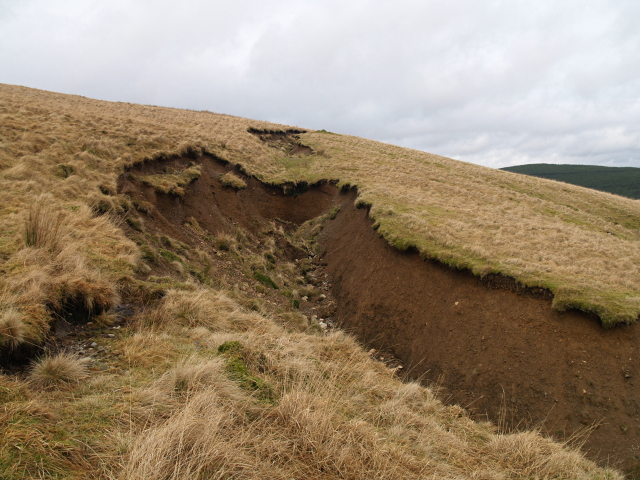Gully
|
This eroded gully was found near Baden Hill in the Scottish Borders. It may be an old drainage ditch that heavily eroded in a flash flood. |
Contents |
[edit] Introduction
A gully is a type of land formation (such as a ravine, ditch or trench) typically caused by erosion. In Scotland and Northern England, a gully is also a type of large knife that is sometimes used in the kitchen or farmhouse. Despite having nautical associations, a gully knife is not meant to be a weapon, although it may have been used to cut sails.
The term gully is not the same as gulley, which is a fitting with a chamber which is designed to collect rainwater, wastewater and groundwater, conveying it to an underground surface-water sewer. Confusingly however this is often spelt 'gully'. For more information, see Gulley.
One of the earliest appearances of the term gully was in the 1600s. The word has French origins and is associated with the term goule, which can be interpreted to mean mouth.
[edit] How gullies form
Gullies are generally caused by running water which creates a ditch or valley in the landscape.
Gully erosion commonly occurs on hillsides when vegetation is removed by processes such as overgrazing, fires, storms and so on. Human modifications to the landscape can also make hillsides susceptible to gully erosion. Deforestation, site development, hydraulic mining and other types of human activity can make it easier for loose soil to be carried away by flowing water - resulting in gully erosion.
Sometimes sinkholes can be associated with gully erosion, since both are almost always the result of a concentrated flow of water. For example, a sinkhole may trigger the formation of a new gully after a pipe or roadway collapse, or it may extend an existing gully.
[edit] Problems with gullies
Regardless of their origins, gullies will generally grow once they have formed and will continue to grow unless erosion issues are addressed.
The production and transportation of sediment that is caused by the creation of a gully may have a negative effect on downstream ecosystems. It can even clog or contaminate waterways.
As well as damage to the landscape, the development of gullies can lead to agricultural issues around farm operations and can also cause damage to private property.
[edit] Related articles on Designing Buildings Wiki
Featured articles and news
Professional practical experience for Architects in training
The long process to transform the nature of education and professional practical experience in the Architecture profession following recent reports.
A people-first approach to retrofit
Moving away from the destructive paradigm of fabric-first.
International Electrician Day, 10 June 2025
Celebrating the role of electrical engineers from André-Marie Amperè, today and for the future.
New guide for clients launched at Houses of Parliament
'There has never been a more important time for clients to step up and ...ask the right questions'
The impact of recycled slate tiles
Innovation across the decades.
EPC changes for existing buildings
Changes and their context as the new RdSAP methodology comes into use from 15 June.
Skills England publishes Sector skills needs assessments
Priority areas relating to the built environment highlighted and described in brief.
BSRIA HVAC Market Watch - May 2025 Edition
Heat Pump Market Outlook: Policy, Performance & Refrigerant Trends for 2025–2028.
Committing to EDI in construction with CIOB
Built Environment professional bodies deepen commitment to EDI with two new signatories: CIAT and CICES.
Government Grenfell progress report at a glance
Line by line recomendation overview, with links to more details.
An engaging and lively review of his professional life.
Sustainable heating for listed buildings
A problem that needs to be approached intelligently.
50th Golden anniversary ECA Edmundson apprentice award
Deadline for entries has been extended to Friday 27 June, so don't miss out!
CIAT at the London Festival of Architecture
Designing for Everyone: Breaking Barriers in Inclusive Architecture.
Mixed reactions to apprenticeship and skills reform 2025
A 'welcome shift' for some and a 'backwards step' for others.






















